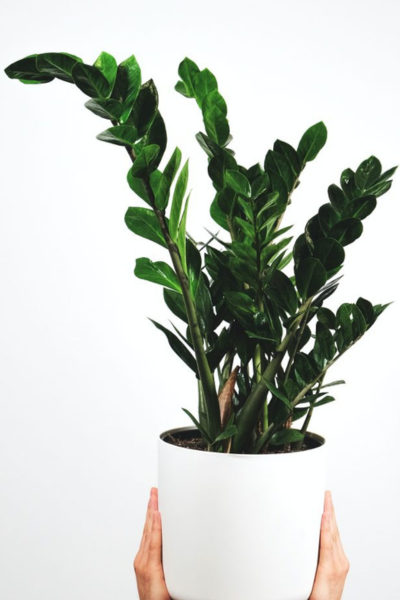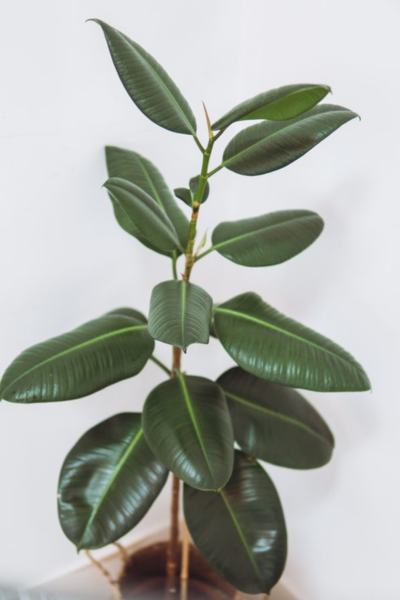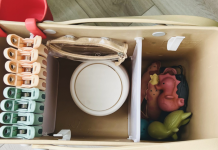 One of the best ways to add a bit of life and beauty to your home is houseplants. Not only are they good for purifying the air, but they have been scientifically proven to help lower stress levels and sharpen your attention.
One of the best ways to add a bit of life and beauty to your home is houseplants. Not only are they good for purifying the air, but they have been scientifically proven to help lower stress levels and sharpen your attention.
It can feel a bit daunting walking into a plant shop, trying to pick the right one. You need to know what kind of soil, light level, and water amount each plant needs to thrive. Plus, if you have pets, some houseplants are toxic if ingested by animals. It can feel like a lot.
My husband and I started our growing plant collection a few years ago and had a rough start. Our first plant baby was an Aloe Vera and we basically liquified it. Don’t ask me how. Now our home is filled with gorgeous and growing plants — the only danger they face now is our toddler’s grabby fingers. We owe a lot of our growth to online help and the staff at local plant shops.
Here are my personal favorite hard-to-kill, laid-back houseplants . . .
Low-Maintenance Houseplants
1. Snake Plant (Sansevieria)
 One of the absolute best plants for someone wanting to start their indoor plant collection is the Snake Plant. It’s known for its large, marbled, sword-like leaves. These bad boys are basically impossible to kill. When we bought our first Snake Plant, the shop told us we could basically pop it on a table, forget about it, and it would be fine. If you want your snake plant to actually grow, that does require a tiny bit more work and attention to the Snake’s needs. Their leaves, when grown as an indoor plant, can be as tall as two feet!
One of the absolute best plants for someone wanting to start their indoor plant collection is the Snake Plant. It’s known for its large, marbled, sword-like leaves. These bad boys are basically impossible to kill. When we bought our first Snake Plant, the shop told us we could basically pop it on a table, forget about it, and it would be fine. If you want your snake plant to actually grow, that does require a tiny bit more work and attention to the Snake’s needs. Their leaves, when grown as an indoor plant, can be as tall as two feet!
Water: Water when soil is completely dry — this ranges from every two weeks to just once a month depending on your individual plant
Sunlight: Indirect sunlight to shaded
Soil Needs: Sandy with good drainage
Toxic if Consumed: Yes
2. Devil’s Ivy Pothos
 This gorgeous climbing plant is one of the first ones I learned to keep alive. When growing indoors, they can vine up to 10 feet. They’re also known for filtering toxins, like formaldehyde out of the air. This plant is one that you can propagate using just water and a jar, creating a new pothos plant!
This gorgeous climbing plant is one of the first ones I learned to keep alive. When growing indoors, they can vine up to 10 feet. They’re also known for filtering toxins, like formaldehyde out of the air. This plant is one that you can propagate using just water and a jar, creating a new pothos plant!
Water: Every 1-2 weeks, allowing soil to dry fully between waterings
Sunlight: Bright, indirect light (but they can tolerate medium to low indirect light)
Soil Needs: Good drainage and rich in nutrients
Toxic if Consumed: Yes
3. Monstera Deliciosa
 The Monstera is one of those eye-catching plants I recommend to everyone interested in indoor plants. There is a wide variety of this plant with variations in leaf color, size, and even the amount of holes within the leaves. You can have your monster grown solo in a planter or you can allow it to grow up a trellis. This gorgeous plant baby is also great for air purification. They’re good starter plants because they’re tolerant of most light conditions, thrive in containers, and can be easily propagated!
The Monstera is one of those eye-catching plants I recommend to everyone interested in indoor plants. There is a wide variety of this plant with variations in leaf color, size, and even the amount of holes within the leaves. You can have your monster grown solo in a planter or you can allow it to grow up a trellis. This gorgeous plant baby is also great for air purification. They’re good starter plants because they’re tolerant of most light conditions, thrive in containers, and can be easily propagated!
Water: During the growing season (summer) every 1-2 weeks, allowing to slightly dry between waterings
Sunlight: Partial/Indirect sun
Soil Needs: Acidic or neutral, peat-based soil with good drainage
Toxic if Consumed: Yes
4. Heartleaf Philodendron
 The heart-shaped leaves on this philodendron are just one of the many reasons these are fantastic starter plants. If cared for properly, these plants can vine out up to 13 feet! They can be potted and placed on a shelf or hung with their vines clipped along the wall. Aesthetically, these little hearts are just so cozy and cute. There are various hybrid heartleaf philodendrons too, including: Autumn coppery-red but gradually transitions to olive green leaves, Black Cardinal bright burgundy to almost black leaves, Majesty dark purple-green leaves, and Prince of Orange shiny orange leaves that fade to green.
The heart-shaped leaves on this philodendron are just one of the many reasons these are fantastic starter plants. If cared for properly, these plants can vine out up to 13 feet! They can be potted and placed on a shelf or hung with their vines clipped along the wall. Aesthetically, these little hearts are just so cozy and cute. There are various hybrid heartleaf philodendrons too, including: Autumn coppery-red but gradually transitions to olive green leaves, Black Cardinal bright burgundy to almost black leaves, Majesty dark purple-green leaves, and Prince of Orange shiny orange leaves that fade to green.
Water: Every 1-2 weeks, waiting for soil to dry out completely
Sunlight: Low to bright indirect light
Soil Needs: Acidic or neutral, peat-moss soil with good drainage
Toxic if Consumed: Yes
5. Dieffenbachia Plant
 The Dieffenbachia plant, also known as the Dumb Cane plant, is simple but stunning. These beauties are known for their big, marbled leaves and can reach up to six feet tall. Dumb Cane plants do have the ability to flower but only under perfect conditions — so don’t be discouraged if yours doesn’t bloom. You can find four variations of this plant, each with its own unique leaf coloring and patterns.
The Dieffenbachia plant, also known as the Dumb Cane plant, is simple but stunning. These beauties are known for their big, marbled leaves and can reach up to six feet tall. Dumb Cane plants do have the ability to flower but only under perfect conditions — so don’t be discouraged if yours doesn’t bloom. You can find four variations of this plant, each with its own unique leaf coloring and patterns.
Water: Keep the Dumb Cane plant’s top inch of soil moist at all times
Sunlight: Any light except direct sunlight
Soil Needs: Any soil mix except sand and orchid mixtures
Toxic if Consumed: Yes
6. ZZ Plant
 The fake-looking leaves of the ZZ plant are always eye-catching. I’ve found myself doubling back in plant stores to touch these plants because I’m not fully convinced they’re real. These shiny plants are sometimes referred to as Zanzibar Gems due to their origins being in Zanzibar and Tanzania. Most sources will tell you that these plants can survive even the most amateur gardener. Black thumb instead of a green thumb? No problem for the ZZ Plant!
The fake-looking leaves of the ZZ plant are always eye-catching. I’ve found myself doubling back in plant stores to touch these plants because I’m not fully convinced they’re real. These shiny plants are sometimes referred to as Zanzibar Gems due to their origins being in Zanzibar and Tanzania. Most sources will tell you that these plants can survive even the most amateur gardener. Black thumb instead of a green thumb? No problem for the ZZ Plant!
*Care note: Never clean the leaves of a ZZ plant with any of the bottled “Leaf Shine” you can find in stores because it can clog the plant’s pores.
Water: Drought-tolerant, once every 1-2 weeks — allow to dry out fully between waterings
Sunlight: Low light to bright, indirect light
Soil Needs: Well-draining, standard potting soil
Toxic if Consumed: Yes
7. Rubber Tree
 The Ficus Elastica (Rubber Tree) was my husband’s first big plant venture. He spotted a little one in a local plant shop and refused to leave without it. It’s been quite the journey for him to learn how to care for this plant that boasts big, shiny leaves. We did make the mistake of exposing our Rubber Tree to too much direct sunlight and wound up with burn spots on the leaves. These houseplants are a bit more on the intermediate level and slightly less forgiving than the ones listed before it. These are tropical plants so they like warmth and moisture/humidity — which, obviously, is not a problem here in South Carolina.
The Ficus Elastica (Rubber Tree) was my husband’s first big plant venture. He spotted a little one in a local plant shop and refused to leave without it. It’s been quite the journey for him to learn how to care for this plant that boasts big, shiny leaves. We did make the mistake of exposing our Rubber Tree to too much direct sunlight and wound up with burn spots on the leaves. These houseplants are a bit more on the intermediate level and slightly less forgiving than the ones listed before it. These are tropical plants so they like warmth and moisture/humidity — which, obviously, is not a problem here in South Carolina.
Water: Water frequently — they like to be kept moist but not drenched
Sunlight: Partial shade (NO direct sunlight)
Soil Needs: Moist with good drainage
Toxic if Consumed: Yes
8. Spider Plant
 While I cringe at the name of this long-leafed plant, Spider Plants are very forgiving houseplants. The long, arching leaves of this plant can grow up to 18 inches long. The adult plants will grow small star-shaped flowers, which can grow fruit when fertilized properly! This is the first of only two non-toxic houseplants on this list. These are safe to be kept within reach, but keep an eye on those long tendrils!
While I cringe at the name of this long-leafed plant, Spider Plants are very forgiving houseplants. The long, arching leaves of this plant can grow up to 18 inches long. The adult plants will grow small star-shaped flowers, which can grow fruit when fertilized properly! This is the first of only two non-toxic houseplants on this list. These are safe to be kept within reach, but keep an eye on those long tendrils!
Water: These plants are sensitive to chlorine and fluoride so water regularly, keeping the soil moist but not drenched, with distilled water.
Sunlight: Partial, indirect light
Soil Needs: Loose, loamy soil with good drainage
*Care Note: From spring to fall (growing season), make sure to regularly fertilize your spider plant!
Toxic if Consumed: No
9. Prayer Plant
 The Prayer Plant (Maranta leuconeura) is named after 16th-century Italian physician and botanist, Bartolomeo Maranta. It got its common name from the fact that the colorful leaves lay flat and outstretched during the day but close up like praying hands at night. What always draws me to these tropical plants is the mix of colors in each leaf, especially the soft red veins. Do note that these bad boys prefer greenhouse-like conditions.
The Prayer Plant (Maranta leuconeura) is named after 16th-century Italian physician and botanist, Bartolomeo Maranta. It got its common name from the fact that the colorful leaves lay flat and outstretched during the day but close up like praying hands at night. What always draws me to these tropical plants is the mix of colors in each leaf, especially the soft red veins. Do note that these bad boys prefer greenhouse-like conditions.
Water: Every 1–2 weeks, allowing the soil to dry out halfway between waterings
Sunlight: Medium to bright indirect light (direct light can burn leaves!)
Soil Needs: Moist with good drainage
Toxic if Consumed: No
10. Aloe Vera Plant
 Okay, so this is one I am 50/50 on. Our first Aloe Vera was a disaster. I don’t know how but it liquified and just died a horrible death. We gave up on Aloe for a while before we spotted a really lovely one at Costco, of all places. This one has gone much better and only part of it has died. I feel like this is a success. Aloe Vera is a great one to keep around in the South, especially during the summer, since the inside of its leaves are filled with soothing aloe gel. Aloe Vera, under the right conditions, can also flower!
Okay, so this is one I am 50/50 on. Our first Aloe Vera was a disaster. I don’t know how but it liquified and just died a horrible death. We gave up on Aloe for a while before we spotted a really lovely one at Costco, of all places. This one has gone much better and only part of it has died. I feel like this is a success. Aloe Vera is a great one to keep around in the South, especially during the summer, since the inside of its leaves are filled with soothing aloe gel. Aloe Vera, under the right conditions, can also flower!
Water: Regular watering, allowing to dry fully between
*Care Note: Aloe vera goes dormant in the winter and won’t require any watering.
Sunlight: Bright, indirect light
Soil Needs: Sandy soil or cactus potting mix
Toxic if Consumed: Yes
Additional Info on Plant Care & Toxicity
If you find that any of your plant babies are dealing with spider mites and mealybugs, you can treat it with the natural insecticide known as Neem Oil.
*Please note, the toxicity when consumed refers to both pets and children. If you (like me) have a little one who loves to put things in their mouth, please be diligent about where you place plants that cannot be safely consumed.
For a quick guide to non-toxic plants, click here!













